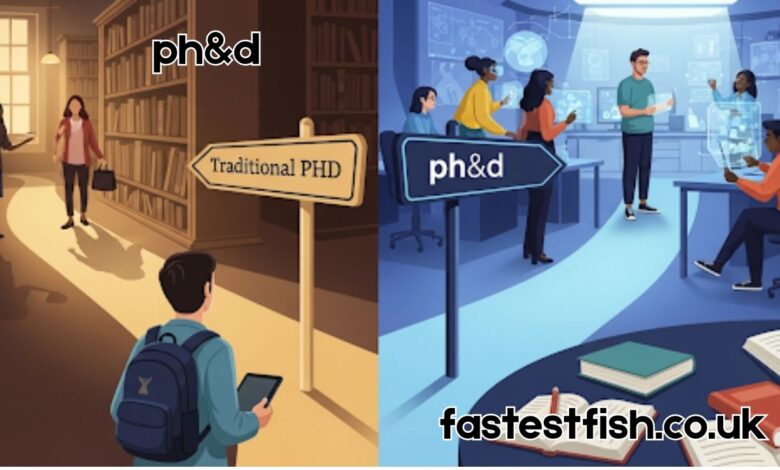Understanding the World of ph&d: Insights, Trends, and Future Impact

Introduction to ph&d
In today’s evolving landscape of research, academia, and innovation, the term ph&d represents more than just an abbreviation. It encapsulates a modern, adaptive, and integrated view of higher education and specialized expertise. Whether you’re a scholar, student, entrepreneur, or simply a curious reader, understanding the depth of ph&d can unlock new perspectives in how knowledge is created, applied, and evolved.
The Origin and Evolution of ph&d
The concept of ph&d stems from the traditional Ph.D. (Doctor of Philosophy), but the inclusion of the ampersand (“&”) signifies an intersection of disciplines, practice, and real-world application. Where a Ph.D. traditionally emphasizes theoretical research, ph&d symbolizes a blend of academic rigor with interdisciplinary relevance.
Over the years, the education sector has witnessed a paradigm shift. The rise of ph&d programs in various institutions reflects a growing need for scholars who not only generate knowledge but also apply it in practical, diverse contexts.
What Makes ph&d Different?
Unlike a conventional doctoral journey, ph&d is characterized by:
- Interdisciplinary collaboration
- Industry integration
- Practical problem-solving
- Policy influence
These elements make ph&d a versatile framework, preparing individuals to work across boundaries in academia, industry, and government. The keyword ph&d thus becomes a label for a new kind of expert—one who merges depth with breadth.
Current Trends in ph&d Research
In recent years, the academic world has seen a surge in ph&d programs centered around real-world challenges. From climate change and public health to artificial intelligence and ethics, ph&d scholars are leading the way in tackling pressing global issues.
Key trends include:
- Cross-institutional programs involving international collaboration
- Funding models that tie academic research to public benefit
- Greater involvement of non-academic stakeholders in research design
These trends indicate how the relevance of ph&d is being recognized on a global scale.
Applications of ph&d in the Real World
One of the most powerful aspects of ph&d is its applicability. Unlike many research efforts that remain confined to journals, ph&d findings are often deployed directly into communities, technologies, and policies.
For example:
- A ph&d project in urban development might collaborate with city planners to redesign inclusive spaces.
- A ph&d initiative in mental health could involve therapists, patients, and software developers to create user-friendly platforms.
By integrating stakeholders throughout the process, ph&d projects ensure their outcomes are meaningful and scalable.
Challenges Facing ph&d Programs
While the rise of ph&d offers many advantages, it also comes with challenges:
- Recognition: Traditional institutions may hesitate to embrace the hybrid nature of ph&d programs.
- Assessment: Measuring success in ph&d projects is more complex than counting publications.
- Funding: Some grants are not structured to support collaborative, applied research.
However, many universities and governments are adapting quickly, recognizing that ph&d is essential for addressing 21st-century challenges.
ph&d and the Job Market
Graduates with a ph&d credential often find themselves uniquely positioned in the job market. Their ability to bridge theory and practice makes them valuable across sectors:
- Academia: Teaching and mentoring roles that require innovation in pedagogy.
- Industry: Research and development, strategy, or consultancy positions.
- Policy: Government roles that demand evidence-based decision-making.
Employers increasingly value the cross-functional skills and adaptive thinking that a ph&d education fosters.
The Role of ph&d in Social Innovation
Social innovation relies on understanding complex human systems and designing effective interventions. Here, ph&d plays a critical role by embedding scholarly work into community-centered projects.
Examples of this include:
- Developing education programs that reflect cultural values
- Creating sustainable food systems with local input
- Addressing inequality through participatory research
In each case, ph&d methodologies prove essential in bridging the gap between academic inquiry and social action.
Global Perspectives on ph&d
From Europe to Asia, North America to Africa, ph&d programs are taking unique shapes across regions:
- In Germany, research-oriented ph&d tracks often link universities with tech incubators.
- In India, initiatives focus on grassroots development and indigenous knowledge systems.
- In Australia, ph&d formats integrate environmental research with policy innovation.
This global variation shows how adaptable and influential ph&d has become as a model.
The Digital Revolution and ph&d
Technology has transformed how research is conducted, and ph&d programs are leveraging these changes:
- Digital ethnography tools to study online communities
- AI-powered analytics for large data sets
- Collaborative platforms like GitHub and Slack for team research
These tools enhance the ph&d experience, making it more interactive, efficient, and impactful.
ph&d and Equity in Education
Another notable dimension of ph&d is its focus on access and equity. Many programs prioritize inclusion, ensuring marginalized voices are part of both research and leadership.
By design, ph&d rejects the ivory tower mentality. It welcomes diversity, respects community wisdom, and works toward systemic change.
The Future of ph&d
Looking ahead, ph&d is likely to become the gold standard in doctoral education. As complex challenges demand complex solutions, the hybrid model of ph&d is not just helpful—it’s necessary.
Future directions may include:
- Increased use of virtual and augmented reality for immersive learning
- Institutional partnerships for shared resources
- Co-authored dissertations with stakeholders from non-academic sectors
The evolution of ph&d signals a more connected, compassionate, and action-oriented future.
How to Pursue a ph&d
If you’re considering a ph&d path, here’s how to get started:
- Research programs that emphasize interdisciplinary work and social relevance.
- Identify mentors who value collaboration and innovation.
- Engage with communities or industries where you want your research to have an impact.
Choosing ph&d is about more than earning a degree—it’s about joining a movement.
Case Studies in ph&d Success
Many successful projects have emerged from ph&d frameworks:
- A water conservation project in Brazil that led to national policy reform.
- A healthcare access initiative in rural Canada that improved outcomes for Indigenous populations.
- An AI ethics guideline developed through collaborative research between a university and a tech company.
Each of these highlights how ph&d is shaping the real world.
Tools and Platforms That Support ph&d Work
The right tools can enhance ph&d productivity and communication. Popular resources include:
- Miro and Notion for collaborative project management
- Zotero for research organization
- Qualtrics for data collection
Many ph&d candidates also use social media platforms like LinkedIn and Twitter to share their research and engage broader audiences.
Criticism and Misconceptions
Despite its many strengths, ph&d sometimes faces criticism. Common misconceptions include:
- It’s “less rigorous” than traditional Ph.D. programs.
- It lacks focus.
- It’s only useful in niche sectors.
These assumptions ignore the extensive training and strategic thinking required in ph&d programs. As more success stories emerge, perceptions are beginning to shift.
Conclusion: Why ph&d Matters
In a world that increasingly values adaptability, cooperation, and purpose-driven work, ph&d stands out as a model for the future. It doesn’t just prepare scholars—it prepares changemakers.
Whether you’re looking to innovate in health, education, tech, or community development, ph&d provides the tools, perspective, and network to make a difference.
Let’s embrace ph&d not only as a qualification but as a philosophy that reshapes how we learn, teach, and lead.
Also Read: Exploring the k c kingdom: A Comprehensive Guide to Kansas City’s Vibrant Culture and Community
